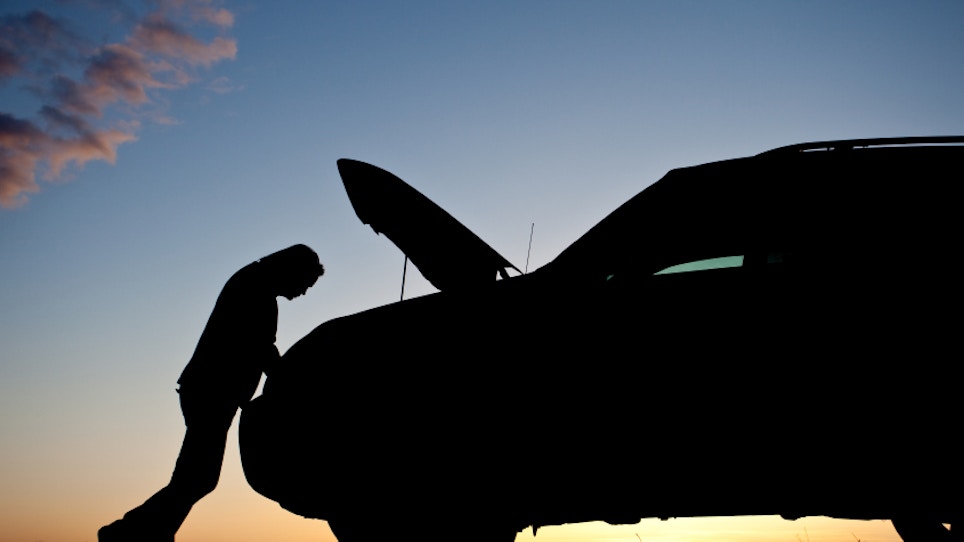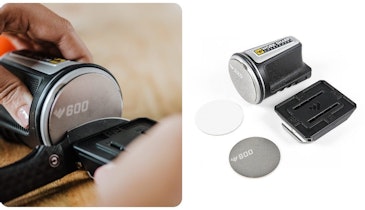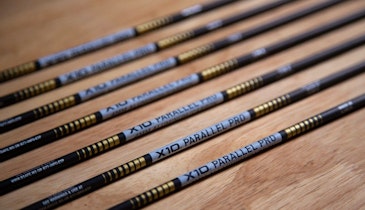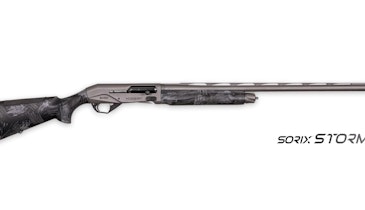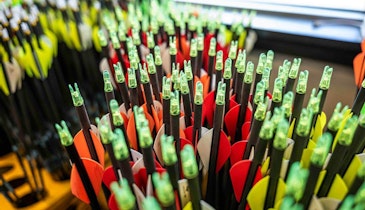It’s hunting season, and that means we’re squeezing in as much time in the woods as we possibly can. If you’re like me – full-time job, two kids and a husband who thinks that throwing a load of clothes in the washer and pushing “Start” counts as doing laundry – you probably find yourself driving a lot early in the morning or late at night in pursuit of your outdoor passion.
And while you may feel confident in the woods, a roadside emergency is an entirely different matter. A flat tire on a recent business trip – and a subsequent shady encounter with an overly helpful “Good Samaritan” – made me question my preparedness in terms of safety on the road.
Fortunately, that business trip involved meeting with Brite-Strike, a manufacturer of tactical flashlights, survival knives and personal safety devices. I spoke with Brite-Strike President Glenn Bushee, who has over 30 years of law enforcement experience, to get his input on how to stay safe when things don’t go as planned.
Safety Tip #1: Call For Help
No one can help you if they don’t know where you are. If you’re stranded on the side of the road, the first thing you need to do is call someone you know.
“If you have a cellphone, you want to call someone right away,” Bushee said. “Enable your GPS so people can see where you are. Then call the local police or 911. Tell them you’re alone on the road. Let them know you’ve got your phone with GPS on it. If things go bad, they can call the phone company and get what they call a ‘ping.’ They’ll get your location.”
Safety Tip #2: Assess Your Situation
Stay in the car or get out? I was taught to get out of the car and get as far away from the road as possible. That may save you in the event that a distracted driver plows into the back of your disabled vehicle, but it also makes you more vulnerable to people with bad intentions. So what’s best?
“It depends on the situation,” Bushee said. “If it’s a busy road, that’s an advantage because there are a lot of people coming by and your chances of having a cop come by are much greater than some quiet back road.
“Make your calls first. If you still don’t feel safe, only then get out of the car.”
As for changing a flat tire on the side of a busy road, Bushee does not recommend it.
“It’s almost not worth trying to change a spare tire today on the road unless you can get completely off the road,” he said.
Your life is worth more than the cost of a tow. If changing your tire means crouching beside the road while countless drivers – some of whom may be texting, trying to input a location in a GPS unit or are otherwise distracted – speed past, call a tow truck.
Safety Tip #3: Be Well Lit
The more visible you can make yourself, the better off you’ll be. Brite-Strike APALS – that stands for All Purpose Adhesive Light Strips – are small LED lights that pack a big punch in terms of brightness. With just a push of a button, they can be set to steady on, strobe or off, and the heavy-duty 3M adhesive on the back means you can place them pretty much anywhere. Bushee recommends putting a couple on the back of your car as an added warning to other motorists.
You can also use APALS for biking, camping, diving, boating and other outdoor sports. And aside from their safety applications, APALS are great for marking treestands and trails. APALS offer 200 hours of run time and can be seen from up to a mile away.
Safety Tip #4: It’s Okay To Lie
This one goes against everything my mother taught me, but if a stranger stops to help you, it’s okay to fudge the truth a bit.
“I wouldn’t let on to them that you’re alone,” Bushee said. “You want to act very confident. Give them a story like, ‘I just called some friends of mine. They should be along here in a few minutes.’ It’s okay to tell him a story that would imply you have a gun, like that you’re going to a shooting event. If the guy says, ‘Oh, are you carrying a gun?’ you can say, ‘You never know.’ Something very noncommittal.
“These guys are looking for an easy mark. He’s going to think, ‘She’s already said somebody’s on the way.’ He doesn’t know how quickly they’re going to get there. In addition, you might be carrying a gun. At that point, if he’s thinking about doing something stupid, he might say, ‘It looks like you’re all set. Have a great day.’ Or he might help you. You feel more comfortable and you didn’t say anything that makes you seem like you’re being a jerk to him.”
Safety Tip #5: Communication Is Key
If someone stops to help you, it doesn’t hurt to have someone else aware that you’re not alone. Bushee recommends sending out a description to your friends of anyone who stops to help you.
“Don’t do anything to set the guy off, but send a text to somebody: ‘Somebody just pulled up to help me. Here’s the kind of car he’s driving,’” he said. “Give the license plate number if you can read it. Do it in a text so the guy doesn’t hear you.”
If you start to get concerned, you can also make a surreptitious phone call, leaving the phone line open so that someone who knows you’re not alone can hear what’s going on. Use that opportunity to ask the person who has stopped more about him: where he’s from, what he does for a living or other small-talk questions that would naturally come up in a conversation. If something does go horribly wrong, the person on the other end of the phone will know about it immediately and will be able to supply the police with critical information.
Safety Tip #6: Keep The Right Gear In Your Car
Whether it’s a flat tire, an accident that ends with your car submerged in water or a snowstorm that leaves you stranded, an emergency situation is much less of an emergency when you have the right gear with you. Bushee recommends keeping a quality flashlight – Brite-Strike has several to choose from – with you at all times. A few APALS in your glove compartment don’t take up much room and are useful to have in countless situations.
“Depending on the state, if you have a gun permit you can keep a gun in the car,” Bushee added. “Most states allow you to carry a gun in the vehicle even if you don’t have a carry permit.
“Get some pepper spray. You can’t take it on a plane. I don’t think you can even carry pepper spray in your luggage anymore because they’re afraid it’s going to blow up in the back of the plane. But you could carry pepper spray in a gel form. It’s very effective.
“Also, get a good light with a strobe on it. The strobe’s not going to do you any good during the day. That’s when you have to rely on the pepper spray.
“Our Survival Key Fob is a good thing to leave on your keys. You’ll probably never need that. But in a situation where you need it, the stuff we put inside works. It’s MIL SPEC paracord. It’s the best quality that I could get. The firestarter works; the tiny knife in there works. If you ever need it, it will be there for you.”
Flying somewhere? Bushee recommends putting a knife like the Brite-Blade Survival Knife in your checked luggage. In addition to being a premium-quality knife, the Brite-Blade boasts a carbide window punch, seat belt cutter, Fire Starter striking tool, and magnetic, moveable mini LED white and red flashlights.
Another product to consider is the CAPS (Camp Alert Perimeter Security) system, which can be used on hotel room doors and apartment windows and can serve as a bear alarm when you’re camping.
“It’s a very low-cost, easy-to-operate, quick-to-set-up, no-fail security system,” Bushee said. “The CAPS has an adhesive backing. You stick one on the wall right above the door, and you have about a foot of fishing line across the door. So if somebody happens to open the door at night, the alarm goes off and it starts flashing. Hopefully the noise and the flashing lights would scare the person away, but if not at least you’re awake and can do something about it.”
Safety Tip #7: If You’re A Woman, Buy Gear Made For Women
The Lightning-Strike personal alarm system is, like many products made for women, pink. But that’s not the only thing about the Lightning-Strike that makes it tailored for use by women.
“We found about 80 percent of guys usually switch on a flashlight with their thumb, and about 80 percent of women use their forefinger,” Bushee said. “We revamped the switch we were using on our tactical flashlights so it can be turned on with the forefinger. We also made it a two-sided switch so young women with long fingernails can activate the switch.
“We included a strobe so you could touch it one time and it would go to strobe to distract and disorient an attacker. We put a whole training program together called ‘Flash, Bash and Dash.’ The idea behind it is to flash somebody in the eyes with the bright light in strobe. Then you give them a good shot wherever you can hit. And then there are a couple of easy spin-snap moves to break the hold and run away.”
The Lightning-Strike also incorporates an alarm. The pin on the alarm was inspired by the pin on a Claymore mine; it pulls out completely and the alarm won’t stop while the pin is out. With other alarms, the pin pulls out just a small amount, making it easy for someone else to quickly push it back in.
Safety Tip #8: Don’t Go Cheap
Not all products are created equal. Worse, since you won’t use many of these products until you need them, you won’t find out whether or not they work until your life depends on them – which is all the more reason to make a sound investment.
Take the Brite-Blade Survival Knife and its carbide window punch, for example. Carbide is expensive, and adding a real carbide punch to the knife really increases the price. It seems a little silly to spend so much when you can get a window punch for much, much less.
“When it comes to window punches, a lot of manufacturers use stainless steel, steel, aluminum, something like that,” Bushee said. “None of it works. It’s not strong enough to break a windowpane on a car today. It actually has to be high-grade carbide, which is one of the things that increases the cost.
“You never think you’re going to need this stuff until you need it. Some things you can get by with, but there are other things that you don’t want to chintz. You want to know these things are built right. You want to know that the blade you have on a pocket knife is going to stay sharp. Everybody wants to save money. But when you need something like a window punch, that could be a life-or-death situation for somebody.”
Safety Tip #9: Trust Your Gut
No product is as important as listening to your own gut instincts. Even a gun can be useless if you’re caught off-guard. If you feel that a person or situation is dangerous, don’t just push aside those feelings. Sure, your rational side may be convinced that you’re being overly paranoid. But I’d much rather be someone who’s paranoid and makes it home safely than someone who’s naïve and does not.
